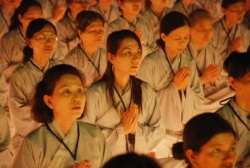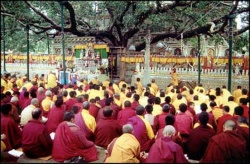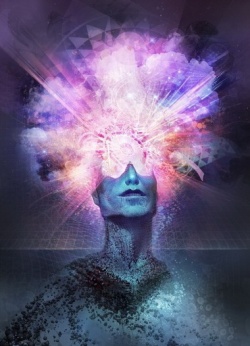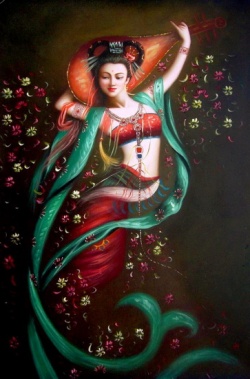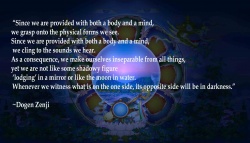Ten Aspects of the Mahayana
as presented in Arya Asanga’s Mahayanasamgraha (Summary of the Great Vehicle) (10 themes found only in the Great Vehicle, to be realized in the sequence presented here; aspects 1-3 are upheld only by Yogachara School; 4-10 are upheld by all of Mahayana)
1. Alaya-vijnana (storehouse/repository/container consciousness) – 8 consciousness system; see below
2. Trisvabhava / trilakshana (3 natures / 3 characteristics) – paratantra (other-dependent – all manifestations of consciousness, born of alaya),
parikalpita (imputational/completely imagined/ conceptually grasped – as something established by way of its own character), parinishpanna (thoroughly established/ completely perfected/perfectly real);
parinishpanna is the absence of parikalpita in paratantra – this is suchness, ultimate essencelessness, the object of observation for purification
3. Vijnaptimatra (mere concept/consciousness-only/cognition-only) – realization of parinishpanna and that all objects of experience are therefore just manifestations of consciousness, born of alaya;
darshanamarga (path of seeing) is entered at first direct cognition of vijnaptimatra - this is 1st bodhisattva bhumi
4. Paramita (6 or 10 perfections) –
dana (giving),
shila (morality),
kshanti (patience),
virya (diligence),
dhyana (meditation),
prajna (wisdom),
upayakaushalya (skillful means),
pranidhana (aspiration),
bala (power),
jnana (knowledge);
these paramitas are both the condition and the result of realization
5. Bodhisattva-bhumi (10 grounds/levels/stages of awakening beings) –
pramudita (joyous),
vimala (stainless),
prabhakari (luminous),
arcismati (radiant),
sudarjaya (unconquerable),
abhimukhi (directly facing),
durangama (far going),
achala (immovable),
sadhumati (good intellect),
dharmamegha (cloud of teachings) –
10 paramitas are practiced on 10 bhumis, successively, on bhavana-marga (path of cultivation);
this is applying vijnaptimatra (nonduality of subject and object) to each paramita
6. Bodhisattva-shila (precepts of awakening beings) – embracing and sustaining discipline and deportment, embracing and sustaining wholesome qualities, embracing and sustaining living beings
7. Mahayana samadhi (great vehicle concentrations/absorptions) – Heroic March, Ocean Seal, etc.
8. Nirvikalpa-jnana (nonconceptual/nonimaginative wisdom/knowledge) – same as prajna-paramita (perfection of wisdom); direct realization of suchness (6,7,8 are Mahayana version of the basic path)
9. Apratishtita-nirvana (non-abiding liberation/cessation/unbinding) – complete non-attachment to both samsara and nirvana; this is ashraya-paravrtti (transformation/conversion/revolution of the basis) – paratantra is converted from imputation to reality, alaya-vijnana is transformed into perfect mirror jnana
10. Trikaya (3 bodies of Buddha) – dharmakaya (inconceivable truth body), sambhogakaya (enjoyment/ bliss body – appears only to bodhisattvas), nirmanakaya (illusory/transformation body); these 3
bodies manifest at ashraya-paravrtti – Buddhahood is ashaiksha-marga (path of no more learning)
Eight Consciousnesses of the Yogachara School as presented in Sandhinirmochana Sutra (ch.5), Lankavatara Sutra, Asanga’s Mahayanasamgraha (ch.1), Vasubandhu’s Vijnaptimatratasiddhi; early Buddhism taught only first 6 consciousnesses
1-5. Chakshur/shrotra/grahna/jihva/kaya-vijnana (eye/ear/nose/tongue/body consciousness)
6. Mano-vijnana (mental consciousness) – awareness/cognition/discernment which ascribes names to objects, directly perceives emptiness, misconceives duality, etc.; awareness of activity of klishta-manas
7. Klishta-manas (afflicted mind/intellect – the mental sense organ, afflicted with view of self, confusion regarding self, pride in self, attachment to self; it is the source of the imputational character; it conceives alaya to be the self of the person, until hinayana stream-entry or 1st bodhisattva bhumi
8. Alaya-vijnana (storehouse/repository/container consciousness) – the basis into which karmic actions leave vasana (permeations) or bija (seeds), which in turn give rise to sense organs, objects, the 7 other consciousnesses, and habits (the whole dependently arisen world of experience) – all pervaded by a sense of duality of perceiver and perceived;
alaya is what “flows” through deep sleep, transmigrates in rebirth, and connects body and mind – though it is not a permanent self; it continues until arhatship or 8th bodhisattva bhumi (when no more seeds are deposited and all stored seeds have come to fruition), when it is called fruition consciousness – at Buddhahood it is transformed into perfect mirror jnana
3 Characteristics of all Phenomena (in Chapters 6&7 of the Samdhinirmochana Sutra)
1. Imputational Character (parikalpita - completely imagined, mere fantasy, conceptually grasped, projected; this is a non-existent imputational character - there are existent imputational characters, like uncompounded space, which are also referents of words, but do not exist by way of their own character)
It is that which is imputed as (imagined as, posited by) a name or symbol (to the objects of conceptual activity, the signs of compounded phenomena) in terms of the own-being (svabhava - identity, essence, entity) or attributes (particulars) of phenomena in order to subsequently designate (impute) any convention whatsoever.
It is known in dependence upon names that are connected with signs (nimitta). It is a lack of own-being in terms of character (marks, characteristics, traits, features - lakshana-nihsvabhavata)…
It is posited as (defined by) names and symbols, but it does not subsist by way of its own character (by inherent definition).
(Jang-gya definition): It is the (false) establishment of an (other-dependent) phenomenon by way of its own-character (svalakshana) (from its own side) as the referent (ground, base of imputation) of a conceptual consciousness or of a word (name, designation, apprehension), and the (false) establishment of object (perceived, phenomena) and subject (perceiver, consciousness) as separate entities.
(Svabhava: inherent existence, entity, substance, essence, own-being, intrinsic being, selfexistence, self-nature; basically equivalent to svalakshana:
natural existence, own-character) 2. Other-Dependent Character (paratantra – other-powered, dependent origination; objects of conceptual activity, bases of the imputational character, signs (or that which has the signs) of compounded phenomena)
It is simply the dependent origination (dependent co-arising) of phenomena .
It is known in dependence upon strongly adhering to the other-dependent character as being the imputational character (being superimposed on the imputational character). It is a lack of own-being in terms of self-production (birth - utpatti-nihsvabhavata)…It arises through the force (dependent on the power) of other conditions and not by itself.
(Asanga’s definition): It is all the consciously constructed differentiations (vijnapti – concepts) that have alaya as their seed…
They correspond to the (6 sense organs, 6 sense objects, 6 consciousnesses). 3. Thoroughly Established Character (parinishpanna - completely perfected, perfectly real, consummate; its realization is equivalent to realizing that all objects of experience are mere consciousness;
this is vijnaptimatrata - mere concept, consciousness-only, perception-only, ideation-only, cognition-only, mere representation of consciousness, mere denomination, pure information, only constructs of consciousness; it is realized directly and non-conceptually on the Path of Seeing)
It is the suchness (tathata - thusness) of phenomena. Through diligence and proper mental application (it is realized)…
It is the other-dependent char. not thoroughly established as being the imputational char. It is known in dependence upon absence of strong adherence to the other-dependent character (dependent co-arising, interdependent origination) as being the imputational character.
It is an ultimate lack of own-being (essence - paramartha-nihsvabhavata)…It is the selflessness of phenomena…the object of observation for purification…ultimate truth. Other-powered (characters) are permanently and forever thoroughly not established as (having) the imputational (character), and are without that inherent nature; just that non-establishment or lack of inherent nature is to be viewed as the thoroughly established character.
(Jang-gya definition): It is the emptiness (absence) of an (other-dependent) object’s establishment by way of its own character as the referent of a conceptual consciousness or of a term (word) and the emptiness of its being a separate entity from the consciousness apprehending it (of object and subject being different substantial entities, of subject-object duality,
of perceiver-perceived duality). (The thoroughly established character is the absence of the imputational character in the other dependent character.
Other-powered characters are not established by way of their own character as the referents of conceptual consciousnesses or as the referents of words.)
Mind-Only (Chittamatra / Vijñaptimatra / Yogachara) Reading List "The three realms [the desire, form, & formless realms; all of existence) are mind-only (chitta-matra)." Avatamsaka Sutra, Chapter 26: the Ten Stages (pages 746, 751, 1047)
"I have explained that consciousness is fully distinguished by [the fact that its] object of observation is cognition-only (vijnapti-matra)…
The appearances of the forms of sentient beings and so forth are not different from the mind. However, because childish beings with distorted understanding do not recognize these images as cognition-only, just as they are in reality, they misconstrue them… What is the onepointed mind?
It is the realization that: 'This image which is the focus of samadhi is cognition-only.'
Having realized that, it is mental attention to suchness." Samdhinirmochana Sutra, Chapter 8: the Questions of Maitreya (pages 155, 157)
"There are those who have fallen into the dualistic way of thinking, being unable to comprehend the truth of mind-only (chitta-matra); they desire to discriminate a world which is of mind itself.
Body, property, and abode have their existence only when measured in discrimination." Lankavatara Sutra, Chapter 2: Collection of all the Dharmas (page 47 plus many others)
- The Wisdom of Buddha – translated by John Powers, 1994 (Sutra, from Tibetan)
- Buddhist Yoga: a Comprehensive Course – trans. by Thomas Cleary, 1995 (Sutra, from Chinese) The Scripture on the Explication of Underlying Meaning – trans. by John Keenan, 2000 (Sutra, from Ch.) The Central Philosophy of Tibet – Robert Thurman, 1991 (Tsongkhapa’s commentary on Chapter 7) Emptiness in the Mind-Only School – Jeffrey Hopkins, 1999 (same as above)
- Reflections on Reality: the Three Natures and Non-Natures in the Mind-Only School – Jeffrey Hopkins, 2002 (same as above, plus extensive reflections on three natures, etc.) Absorption in No External World: 170 Issues in Mind-Only Buddhism – Jeffrey Hopkins, 2005 Hermeneutics and Tradition in the Samdhinirmocana Sutra – John Powers, 2004
- The Lankavatara Sutra – trans. by D.T. Suzuki, 1932 (Sutra, from Sanskrit and Chinese) Studies in the Lankavatara Sutra – D.T. Suzuki, 1930 Maitreya Bodhisattva & Arya Asanga (310-390 CE):
Principles of Buddhist Psychology – David J. Kalupahana, 1987 (pp. 149-171) (Madhyantavibhaga, section 1, from Sanskrit)
Distinguishing the Middle from the Extremes (Madhyantavibhaga, from Tibetan) – with commentary by Thrangu Rinpoche, 2000
- Maitreya’s Distinguishing Phenomena and Pure Being (Dharmadharmatavibhaga, from Tibetan) with commentary by Mipham – trans. by Jim Scott, 2004
Distinguishing Dharma and Dharmata (Dharmadharmatavibhaga, from Tibetan) – with commentary by Thrangu Rinpoche, 1999
- On Knowing Reality: the Tattvartha Chapter of Asanga’s Bodhisattvabhumi – trans. by Janice Dean Willis, 1979 (from Sanskrit and Tibetan, excellent introduction on mind-only as well)
- The Summary of the Great Vehicle (Mahayanasamgraha, from Chinese) by the Bodhisattva Asanga – trans. by John P. Keenan, 1992 (summary of Yogachara, based on Sandhinirmochana Sutra) Arya Vasubandhu (320-400 CE):
- Principles of Buddhist Psychology – David J. Kalupahana, 1987 (pp. 173-214) (Vijñaptimatratasiddhi in Thirty Verses & Twenty Verses, from Sanskrit)
- A Buddhist Doctrine of Experience – Thomas A. Kochumuttom, 1982 (Vijñaptimatratasiddhi, Trisvabhavanirdesha, Madhyantavibhagabhashya, from Sanskrit)
Seven Works of Vasubandhu – trans. by Stefan Anacker, 1984 (includes above texts plus more)
- Empty Words: Buddhist Philosophy and Cross-Cultural Interpretation – Jay L. Garfield, 2002 (Trisvabhavanirdesha, from Tibetan)
Vijñaptimatratasiddhi: Thirty Verses of Vasubandhu – commentary by Tenshin Reb Anderson, 1994 Understanding Our Mind (formerly called Transformation at the Base), plus "sequel": Buddha Mind, Buddha Body – Thich Nhat Hanh, 2001, 2007 (new verses based on Vasubandhu) Hsuan-Tsang Commentary on Vasubandhu’s Thirty Verses (600-664 CE): Ch’eng Wei-Shih Lun: Doctrine of Mere Consciousness by Hsuan Tsang – trans. by Wei Tat, 1973 Three Texts on Consciousness Only – trans. by Francis H. Cook, 1999 General:
- Appearance and Reality: the Two Truths in the Four Buddhist Tenet Systems - Guy Newland, 1999 (pp. 41-57) (good summary, Tibetan version)
A Buddhist Doctrine of Experience – Thomas A. Kochumuttom, 1982 (includ. trans. of Vasubandhu) Buddhist Thought in India – Edward Conze, 1962 (pp. 250-260) Cutting Through Appearances – Geshe Lhundrup Sopa and Jeffrey Hopkins, 1989 (pp. 249-278) (formerly called Practice and Theory of Tibetan Buddhism 1976, pp. 107-121)
- Empty Words: Buddhist Philosophy and Cross-Cultural Interpretation – Jay L. Garfield, 2002 Living Yogacara: An Introduction to Consciousness-Only Buddhism – Tagawa Shun’ei, 2009
- Luminous Heart: The Third Karmapa on Consciousness, Wisdom, and Buddha Nature – Karl Brunnholzl, 2009 (especially pp. 3-78, for a thorough overview of Indian Yogacara teachings) Madhyamika and Yogacara: A Study of Mahayana Philosophies – Gadjin M. Nagao, 1991
- Meditation on Emptiness – Jeffrey Hopkins, 1983 (pp. 365-397) (good summary, Tibetan version) Ocean of Eloquence: an Extensive Commentary on the Difficult Points of Alaya-Vijñana and Klista- Manas – trans. by Gareth Sparham, 1993 (Tsongkhapa’s commentary on 8 consciousnesses) Principles of Buddhist Psychology – David J. Kalupahana, 1987 (pp. 122-147)
- Progressive Stages of Meditation on Emptiness – Khenpo Tsultrim Gyamtso, 2001 (pp. 27-43)
- Stars of Wisdom – Khenpo Tsultrim Gyamtso, 2010 (pp. 32-46) (from "meditation" perspective) The Yogacara Idealism – Ashok Kumar Chatterjee, 1962
The Zen Teaching of Bodhidharma – trans. by Red Pine, 1987 (Wake-up Sermon, pp. 47-75) Sun Face Buddha: the Teachings of Ma-Tsu – trans. by Cheng Chien Bhikshu, 1992 (pp. 62-68) – Mazu
- On the Transmission of Mind – trans. by John Blofeld, 1958 (pp. 29-38) sections 1-10 – Huangbo Timeless Spring: a Soto Zen Anthology – trans. by Thomas Cleary, 1980 (p. 35) – Shitou The Blue Cliff Record – trans. by Thomas & J.C. Cleary, 1978, Case 80 – Chao Chou’s Newborn Baby Book of Serenity – trans. by Thomas Cleary, 1990 (pp. xii-xv, Introduction) Case 32 – Yangshan’s Mind and Environment
Case 88 – The Surangama’s Not Seeing
Case 91 – Nanquan’s Peony
- Eihei Dogen’s Shobogenzo (Treasury of the True Dharma Eye) – trans. by Kazuaki Tanahashi, 2010 6 – The Mind Itself is Buddha (Sokushin zebutsu) – vol. 1 in Nishijima & Cross 19, 20 – Ungraspable Mind (Shin fukatoku) – vol. 1 in Nishijima & Cross 38 – Body-and-Mind Study of the Way (Shinjin gakudo) – vol. 2 in Nishijima & Cross 41 – Painting of a Rice Cake (Gabyo) – vol. 2 in Nishijima & Cross 48 – Three Realms are Only Mind (Sangai yuishin) – vol. 3 in Nishijima & Cross
- Keizan Jokin’s Denkoroku (The Record of Transmitting the Light) – trans. by Francis H. Cook, 1991 Case 23 – Manorhita (also in Transmission of Light trans. by Thomas Cleary) Case 52 – Dogen (same)
(* = Kokyo’s most highly recommended texts on Mind-Only)
